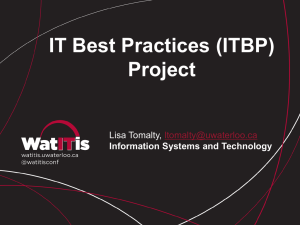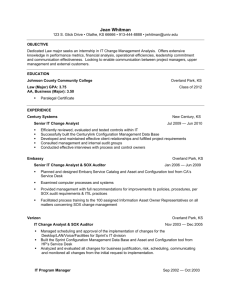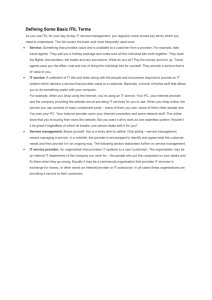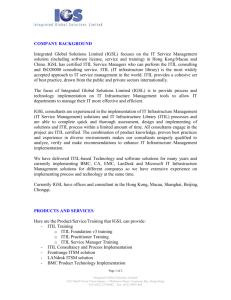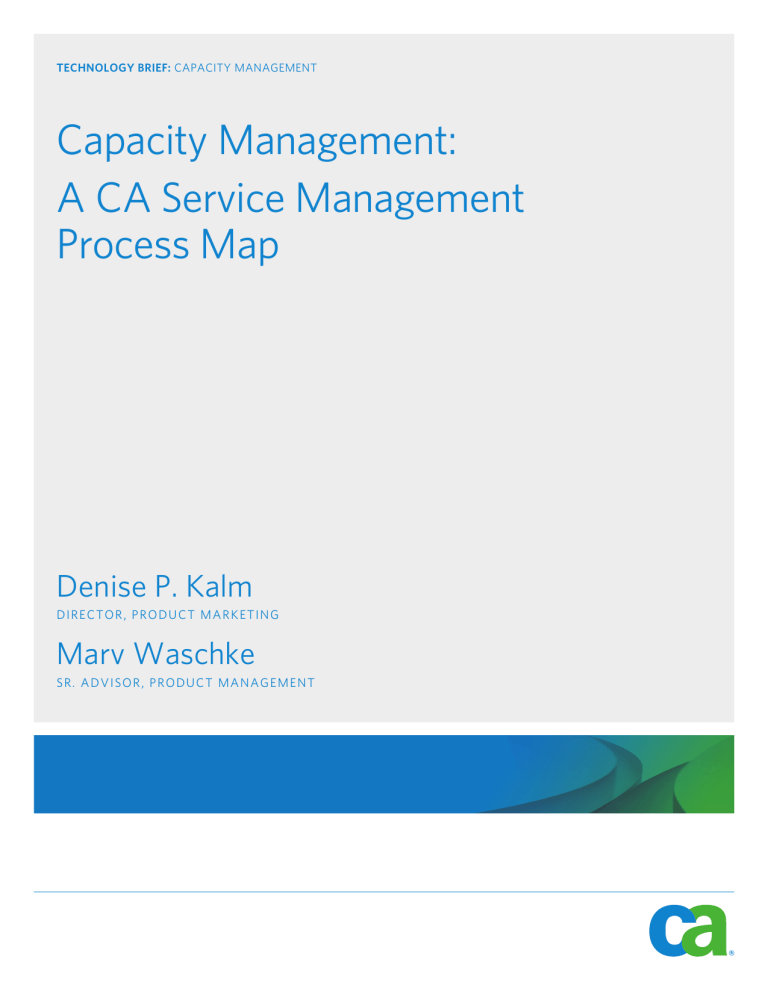
TECHNOLOGY brief: CAPACITY MANAGEMENT
Capacity Management:
A CA Service Management
Process Map
Denise P. Kalm
Director, Product Marketing
Marv Waschke
Sr. Advisor, Product Management
Table of Contents
Executive Summary
1
SECTION 1: CHALLENGE
2
Simplifying ITIL
How to Use the CA Service Management
Process Maps
Finding the Right Path to IT Service Excellence
SECTION 2: OPPORTUNITY
4
Capacity Management
Capacity Management Sub-Processes
Monitor Demand
Analyze
Monitor Performance
Forecast
Creating the Capacity Plan
New Services (Application Sizing)
Procure
Load Test
Adjust
Demanding Management—A Form of
Adjustment
SECTION 3: BENEFITS
12
Benefits of Capacity Management Best
Practices
SECTION 4: CONCLUSIONS
12
Section 5: about the author
13
ABOUT CA
BACK COVER
Copyright © 2009 CA. All rights reserved. All trademarks, trade names, service marks and logos referenced herein belong to their respective companies. ITIL® is a Registered Trademark and a Registered Community Trademark of
the Office of Government Commerce, and is Registered in the U.S. Patent and Trademark Office. This document is for your informational purposes only. To the extent permitted by applicable law, CA provides this document “As Is”
without warranty of any kind, including, without limitation, any implied warranties of merchantability or fitness for a particular purpose, or non-infringement. In no event will CA be liable for any loss or damage, direct or indirect, from
the use of this document including, without limitation, lost profits, business interruption, goodwill or lost data, even if CA is expressly advised of such damages.
Executive Summary
Challenge
The Information Technology Infrastructure Library version 3 (ITIL® V3) process framework
addresses the IT Service Management (ITSM) service lifecycle. The Service Lifecycle is an
organizational model providing insight into the structure of ITSM, with critical guidance
for IT organizations seeking to improve service quality and align closely with business to
create customer and business value.
However, ITIL V3 best practice guidelines for the five phases of the service lifecycle are
complex and challenging to interpret. Moreover, they do not provide definitive guidance
for implementing ITSM processes. Many IT organizations consequently undertake an ITIL
journey without firm goals or plans.
Too often overlooked, the ITIL Capacity Management process focuses on proactive
management of capacity and performance. It provides critical support for many other
processes, such as Availability, Service Level, Financial, Problem, and more. As such, it is a
critical process. The quality of an organization’s Capacity Management can make or break
its reputation with its customers.
Opportunity
Capacity Management seeks to optimize IT capacity to meet Service Level Agreements
(SLAs) in the most cost-effective manner. Capacity Management proactively ensures
that an IT infrastructure will meet both current and future business demands. Gathering
and analyzing relevant data, Capacity Management helps plan for upcoming needs and
optimize purchasing decisions—continuously balancing cost against capacity, and supply
against demand. CA has developed a unique approach to representing the ITIL framework
and its interdependent ITSM processes at a high level in the form of an easy-to-use
subway map. This map is an ideal starting point for understanding and communicating
about ITIL in support of successful planning and implementation.
Benefits
The CA Capacity Management process map enables IT organizations to manage by:
• Spending money on the right things at the right time
• Utilizing the systems and budget you have in the most effective manner
• Giving you the tools to proactively reduce system incidents and problems
• Increasing customer satisfaction
• Anticipating capacity requirements before business is adversely impacted
• Reducing the threat of service degradation through better resource management
• Diminishing the risk associated with changes to the IT infrastructure
Technology Brief: Capacity MANAGEMENT 1
Section 1: Challenge
Simplifying ITIL
The ITIL V3 process framework focuses on the service lifecycle and the structure and linkage
service management components. It embodies critical guidance for IT organizations that are
seeking to improve service quality and align more closely with business goals.
But, the ITIL V3 best-practice guidelines across the five phases of the service lifecycle are
complex and challenging to interpret. Moreover, they are not designed to provide definitive
advice about implementing IT Service Management (ITSM) processes. Many IT organizations
consequently undertake an ITIL journey without a firm idea of their goals and the path to
achieve those goals.
CA has developed a unique approach to charting the ITIL journey through a visual
representation of the ITIL framework and its interdependent ITSM processes modeled after an
urban subway system. This three-part map (Figure A) presents an easy-to-navigate, high-level
view of the ITIL terrain. IT executives, strategists and implementers can use these Service
Management process maps along with the family of CA Service Management process map
technology briefs that expand on them. The maps and technology briefs provide a common
reference point for understanding and communicating about ITIL and help you with program
planning and implementation.
How to Use the CA Service Management Process Maps
CA’s Service Management process maps (Figure A) illustrate every process (or track), each
activity (or station) and the key relationships that are relevant to navigating continuous IT
service improvement. The ITIL quality cycle takes the form of a “circle” with each Plan-DoCheck-Act (P-D-C-A) step as a process integration point (junction) on the line. Junctions
serve both as reference points when assessing process maturity, and as a means to consider
the implications of implementing a process in isolation.
Strategic controls (Service Portfolio Management, Demand Management and Financial
Management) are needed to reduce risk and optimize integration across the service lifecycle,
as illustrated on the three points of the triangle centered in the P-D-C-A quality circle (seen
more easily in Figure B). These strategic controls help in evaluating, prioritizing and assuring
the appropriate levels of financial and human resources for existing and new services.
This paper is part of a series of Service Management Process Map technology briefs. Each brief
explains how to navigate a particular ITIL process journey, reviewing each process activity
that must be addressed in order to achieve process objectives. Along each journey careful
attention is paid to how technology plays a critical role in both integrating ITIL processes and
automating ITIL process activities.
2 Technology Brief: Capacity MANAGEMENT
Service Operation
Service Transition
Service Catalog
Management
Maintain
Business
Services
Release and
Deployment
Management
Test
CAB Review
Execute
(Emergency/
Standard)
Deliver
Required
Resources
Monitor
Services
Service
Validation
and Testing
Maintain Accurate
Service Configurations
Schedule
Change
Availability
Management
Audit
Responsiveness
Validate &
Verify
Specify
Continuity
Requirements
AN
PL
IT Service
Continuity
CT
Report
Achievements
Customer
Satisfaction
Publish
Live Services
Monitor
Performance
Investigate
AN
Configuration
Control
Financial
Management
Manage
Build/Release
Categorize
RFC
Analysis
Deploy
Demand
Management
Access
Management
Problem
Management
Diagnose
Financial
Management
Problem
Control
A
Service
Review
Demand
Management
Prioritize
Change
Management
Select Response
Record
Automate
and Control
A
Revise
SLAs / OLAs
Manage
Issues
Optimize
Availability
Detect
(Incl. Fault Detection)
Review/
Action
Store Info.
Service Level
Management
A
Business
Service
Views
Financial
Management
Technical
Service
Views
Transfer/
Disseminate
Transform
to Usable
Knowledge
Verify
Access Request
Review
and Audit
Mitigate Risk
Demand
Management
Executive
Policy
Filter /
Correlate
Verify
AN
Proactive
Management
Determine
Vulnerabilities
Build Plan
Monitor
Demand
D
D
Perform
Tests
Build
Schedule
Knowledge
Transfer
PL
Assess Risk
Capacity
Management
Provide
Rights
Ensure
Release
Value
Preparation
Preparation
and Planning
Manage
Security Incidents
CT
D
Develop
Strategy
CH
Build Catalog
Contents
Test
CH
Service Portfolio
Management
K
Model/Trend
Document
Service
Definition
Service Portfolio
Management
Analyze
O
Error
Control
EC
O
Analyze
Performance
CH
Service Portfolio
Management
K
Forecast
Requirements
K
Maintain
Policy
O
Event
Management
Record
Service Request
(Incl. Self-Service)
EC
Assess &
Classify Assets
Info. Security
Management
Impact
Analysis
Transition
Planning and
Support
Resolve
Request
Fulfillment
Adjust and Tune
Set Security
Controls
Prevent and
Eliminate
Problems
Raise Incident
Informed
Decisions
Business
Planning
Build
Methods/
Techniques
Incident
Management
Secure
Service Access
Monitor / Track
Adopt
Best Practices
Evaluation/
Decision
PL
Service Design
EC
CA ITSM Process Maps illustrate
at a high level how best to navigate
a journey of continual service
improvement guided by strategic
controls throughout the service
lifecycle. Each map describes the
relevant ITIL processes and activities
you’ll need to work with to reach
your goals.
Figure A
CT
CA ITSM Process maps
Escalate
Known
Errors
Monitor
and Report
Report/
Closure
Coordinate
Resources
Design SLA
Framework
Capture Info.
Approval
(Financial, Compliance)
Identify
Configurations
Catalog
Operational
Services
Manage
and Plan
Deliver
Standardized
Services
Resolve/
Recover
Management
Knowledge
Management
Restore
Service
Service Asset and
Configuration
Meet Business
Requirements
Work
Around
Fulfillment
Assure
Quality
Management
CA has developed three maps that portray the critical ITIL disciplines that most ITSM
discussions focus on: Service Design, Service Transition and Service Operation.
Service Design
Service Catalog
Management
Availability
Management
Maintain
Business
Services
Test
Deliver
Required
Resources
Monitor
Services
Build
Specify
Continuity
Requirements
Methods/
Techniques
Adjust and Tune
Set Security
Controls
Assess &
Classify Assets
D
O
CH
K
Maintain
Policy
Model/Trend
Document
Service
Definition
Service Portfolio
Management
EC
Info. Security
Management
Forecast
Requirements
Analyze
Performance
Build Catalog
Contents
Analyze
Manage
Security Incidents
Test
Assess Risk
Proactive
Management
Capacity
Management
Review
and Audit
Determine
Vulnerabilities
Mitigate Risk
Business
Service
Views
Financial
Management
Technical
Service
Views
A
Demand
Management
Monitor
Demand
Revise
SLAs / OLAs
Service
Review
Manage
Issues
Report
Achievements
Meet Business
Requirements
IT Service
Continuity
Management
Customer
Satisfaction
Publish
Live Services
Service Level
Management
A
N
Build Plan
PL
The Service Design map represents
a journey of developing and improving
capabilities for engineering and
maintaining the appropriate levels
of services in production. The
Capacity Management journey is
drawn in this map.
Figure b
CT
Service Design map
Optimize
Availability
Monitor
Performance
Catalog
Operational
Services
Service Catalog Management
Service Level Management
IT Service Continuity Management
Design SLA
Framework
Key Intersections
Strategic Controls
Capacity Management
Strategic Inputs
Info. Security Management
Continual Service
Improvement
Availability Management
CA CMDB
A Configuration
Management Database
(CMDB) is a critical
element of an ITIL implementation.
CA CMDB provides a single source
of truth about Configuration Item
information and the relationships
between them.
Technology Brief: Capacity MANAGEMENT 3
Finding the Right Path to IT Service Excellence
Most organizations have multiple disciplines in IT that respond directly to the matter of
service availability. That is, many of the functions that decide or constrain availability are
active already but are not strategically coordinated to optimize their collective impact.
Key points in this optimization include:
• Embracing the role of architecture
• Unifying service visibility
• Managing service components using business priorities
A primary outcome of the Capacity Management process is the assurance that cost-justifiable
capacity is available when required across the enterprise, and that there is a close match
between present and planned capacity and the current and future needs of the business.
Section 2: OPPORTUNITY
Capacity Management
The objective of Capacity Management is to ensure that your infrastructure provides the
cost-justifiable resources needed to meet current and future business service requirements,
while ensuring that IT resources are provisioned, managed, utilized and acquired in a costeffective manner.
Capacity Management activities receive inputs from a number of the other ITIL processes. For
example, the Incident Management process informs Capacity Management when incidents
occur due to capacity problems. IT Service Continuity Management provides failover and
disaster recovery capacity requirements for capacity planning. The outputs of Capacity
Management also support many other processes. For example, Capacity Management can
inform Change Management of the need for additional capacity, or about the potential impact
of a new service on current capacity levels. In addition, Capacity Management is instrumental
in ensuring compliance with service levels established through the Service Level Management
process. These integration points are represented in Figure B.
The goals of Capacity Management are to manage all capacity and performance-related
service and resource matters. The Capacity Manager must:
• Create and maintain a Capacity Plan
• Act as an expert and advisor on all capacity and performance issues and needs
• Manage the environment to meet or exceed established service level agreements (SLAs),
while understanding the impact on both services and resources
• Take the role of problem manager for capacity and performance problems
• Evaluate all changes as they might relate to performance and capacity
• Be proactive while being cost-aware
4 Technology Brief: Capacity MANAGEMENT
This translates to the following roles, which may or may not be the function of a single person
or single group:
• Performance monitor — observe patterns of both IT and business activity, perform reporting
activities and solve performance problems noted
• Performance tuner — provide for efficient delivery of SLAs with existing resources
• Capacity planner — understand current and future resource demands and create a forecast
and capacity plan with sufficient future focus to allow time to react
• Capacity and performance policy manager — define thresholds and other policies for
planning purposes
• Resource demand manager — manage resources efficiently through policies
The key Capacity Management activities take place at the various “stations” illustrated in
Figure C, en route to the process terminus, delivering the resources required to ensure that IT
operations and IT Infrastructure support the future capacity of IT services that are required
by the business in the most cost-effective manner. In other words, Capacity Management
assures that currently delivered services and the service infrastructures support the needs of
the business now and in the future. It is important to keep in mind, however, that Capacity
Management is also about understanding the potential for future Service Delivery, so that new
technology can be leveraged where appropriate to cost-effectively deliver the services required
by the business.
This process is a balancing act:
COST
RESOURCES
NEEDED
SUPPLY
DEMAND
There are a number of stops on the Capacity Management process line:
• Monitor demand — Ensure that the capacity of the IT infrastructure matches the
evolving demands of the business in the most cost-effective and timely manner. Capacity
Management can also influence the demand for resources, perhaps in conjunction with
Financial Management.
• Analyze — Process input from performance management, resource management, workload
management, demand management, and application sizing, in order to understand
the demands currently being made for IT resources and producing forecasts for future
requirements.
• Monitor performance — Identify and respond to variations in performance, ensuring the
most efficient resource usage while meeting SLAs.
• Forecast — Produce an annual Capacity Plan enabling the IT service provider to continue to
provide services of the quality defined in SLAs. This activity includes recommendation and
acquisition of resources, testing and delivery.
Technology Brief: Capacity MANAGEMENT 5
Capacity Management
Figure C
The Capacity Management track
ensures that cost-justifiable IT capacity
in all areas of IT always exist and is
matched to the current and future
agreed needs of the business in a
timely manner.
Capacity Management Sub-Processes
Capacity Management consists of a number of sub-processes, within which there are various
activities. The sub-processes of Capacity Management are:
This sub-process is responsible for ensuring that the future
business requirements for IT services are considered, planned for and implemented in a timely
fashion. This timeliness can be achieved by analyzing data on current resource utilization and
gathering business projections and application design plans, in order to forecast and model
future requirements. As with many ITIL activities, successful Business Capacity Management
involves close collaboration between IT and the business.
BUSINESS CAPACITY MANAGEMENT
The focus of this sub-process is the management control
and prediction of the performance of the operational IT services that enable users to perform
day-to-day activities. The focus must be on end-to-end service SLAs rather than the individual
infrastructure components. If you focus narrowly on each IT component first, without
understanding the end-to-end service, the organization risks investing in resources that may
not be needed, and not investing where they are truly needed. In this sub-process, not only is
engagement with the business essential, but cross-platform, cross-technology collaboration
will also be required.
SERVICE CAPACITY MANAGEMENT
This sub-process focuses on the management of
the individual components of the IT infrastructure. This is the “traditional” IT view, and is
responsible for ensuring that all IT components that support a particular IT service are closely
monitored and measured and that exercises are constantly performed to improve service
capacity requirements. Again, a structured and top-down approach to Capacity Management
ensures closer business alignment, and enables the prioritization of capacity investments to
be based on business needs. It is critical to automate thresholds, where possible, to enable
proactive management and minimize degradation and outages.
COMPONENT CAPACITY MANAGEMENT
6 Technology Brief: Capacity MANAGEMENT
Monitor Demand
The Capacity Management journey (like many of the other journeys) begins with monitoring
your current state; in this case, your current service capacity state. Monitoring demand
is about understanding how well you currently support your users’ demands for capacity.
Monitoring of capacity demand levels can tell you how many users require resource and how
much resource each business activity consumes. It also provides valuable information on the
current capacity levels of resources so that IT will know how to support new services as they
are introduced into the environment, as well as how new services will affect current SLAs.
In this case, it is essential to understand effective capacity of a resource, not the theoretical
textbook capacity. A given device may only be able to deliver acceptable performance at 50%
busy; if you do not understand this threshold and assume demand can double in a 50% busy
environment while still meeting SLAs, you may delay upgrades and tuning too long.
Demand monitoring is important because it allows you to collect relevant data for specific
components of services that you can present to the business to facilitate smart and effective
decisions. And this must be assessed to see patterns of demand based on date and time. With
this information, you can make the right decisions every time.
Utilization of each resource and service is monitored on an on-going basis to ensure the
optimum use of the hardware and software resources, that all agreed service levels can be
achieved, and that business volumes are as expected. The monitoring activity of Capacity
Management includes:
• CPU & memory utilization
• I/O rates
• Device utilization
• Queue length
• Storage utilization
• Transaction rate
• Packet rate
• Response time
• Burst rate
• Bandwidth utilization
This monitoring activity can, in turn, trigger typical capacity initiatives such as: archiving,
workload balancing, upgrade projections, tolerance levels, I/O tuning, pricing incentives to
foster workload shifting and data storage tuning.
Monitored data can include CPU utilization or transaction response times (see below), among
other data. However, there is a difference between the information collected around managing
capacity (resource utilization) and the data needed to monitor performance (response time
or throughput). Business decisions are driven by an understanding of both. Technology can
enhance monitoring of thresholds and normal service levels; for example, if thresholds are
exceeded, automated alerts can notify the Service Desk that there is a deviation from the
expected level of capacity and the appropriate escalation procedure is followed. Ideally, the
thresholds should trigger this activity before user impact is felt (soft threshold) to improve
service level compliance.
Technology Brief: Capacity MANAGEMENT 7
So regardless of whichever sub-process (Business, Service or Component Capacity
Management) is involved, monitoring of IT resources is a key activity of the overall Capacity
Management process that should be performed in order to ensure that IT capacity continues
to meet the requirements of the business.
Analyze
The data collected from demand monitoring activities should be analyzed to identify trends,
from which you can establish the normal utilization and service level, or baseline. Some key
Capacity Management metrics include:
• Processor usage by workload and application
• Relative resource consumption
• Minimum/maximum transactions per second
• Online response times and trends
• Batch throughput
• Resource utilization statistics
• Business usage trends
• Processor and I/O usage trends
• Network usage trends
• Workload trends and forecasts
• Growth forecasts
Trending allows you to understand what is considered “normal,” which serves as a benchmark
to compare against any deviation from “normal.” Any deviation from expected utilization
levels, thresholds or response times can be immediately detected and acted upon. (Thus,
the trends you extrapolate from this analysis can also be highly relevant during the Incident
and Problem Management processes.) These trends may be as granular as by hour, by day,
because business workloads are not evenly distributed across the day or week. You may find
such issues as bottlenecks, unbalanced workload distribution, application design inefficiencies,
database design issues, inefficient use of memory and more.
One major value of capacity monitoring and analysis is that the information collected can be
used to predict future activity. Technology can help you here, by predicting future resource
usage, and by monitoring actual business growth against predicted growth. With the
information analyzed, you can make decisions to improve performance or make more efficient
use of system resources. A way to improve these capabilities is by ‘tuning,” which is best
supported by technology to perform such techniques such as work load balancing.
Once monitoring and analyzing the data is underway, you need a way of storing the
information you are gathering. Addressing this storage requirement is where the Capacity
Management Information System (CMIS) comes into play. You might also store the capacity
plan and the forecasts in this data store. The Capacity Management process collects data from
a variety of hardware platforms and software applications that could be widely distributed, so
technology helps considerably to organize that information and make it available in the CMIS.
Make sure that the gathering and maintenance of your CMIS data is identified as business
critical and controlled and protected by the Change Management process, so that Changes
are considered relative to their impact on the CMIS.
8 Technology Brief: Capacity MANAGEMENT
Monitor Performance
At the Monitor Demand stop the discussion touched briefly on monitoring performance;
specifically monitoring response times. A major intersection here at Monitor Performance
is with Service Level Management, since SLAs often reference expected response times,
including end user response time, components of response time, expected response times for
service restoration, escalation and resolution. The monitoring of response times is a complex
process, and technology can greatly ease this activity. Supporting technology can include
network monitoring systems, transaction monitoring systems, distributed agent monitoring
systems, passive monitoring systems, robotic scripted systems with terminal emulation
software or the incorporation of specific code within client and server applications software
that allow for real-time monitoring of user performance.
Forecast
Forecasting activities allow the business to intelligently predict future growth and plan
accordingly for capacity. This can be done in a variety of ways depending on the technology in
question. Armed with this forward-thinking approach, the business can decide to double the
amount of Web-based users of a service, for example, and accurately predict the direct costs
associated with the new usage consumption rates based on current data and growth patterns.
If the capacity forecast indicates a requirement for increased resources, this then becomes an
input to the IT budget cycle. Monitoring and analyzing expected service levels will allow you
to forecast inadequate levels of service if capacity is not planned for with an understanding of
your current state. Some forecasting techniques include:
• Tuning — the analysis of the monitored data may identify areas of the configuration that
could be tuned to better utilize system resources or improve the performance of the
particular service. Some valuable techniques include: balancing workloads and traffic,
balancing disk utilization, defining a workable lock strategy to avoid unnecessary lock
activity, efficient use of memory.
• Implementation — the objective of this activity is to introduce to the live operational service
any changes that have been identified by the monitoring, analysis and tuning activities.
Following implementation, go back to assessment to measure how closely the results
matched expected outcomes.
• Storage of Capacity Management Data — Data in the CMIS is stored and used by all the
sub-processes of Capacity Management. This repository holds a number of different data
types; including business, service, technical, financial and utilization data.
• Modeling — A prime objective of Capacity Management is to predict the behavior of IT
Services under a given volume and variety of work. Modeling is an activity where you can
use activities relating to any of the sub-processes of Capacity Management. Modeling can
predict the behavior of services (performance and resource utilization) under different
circumstances. Depending on your time and budget, you can employ models using
various techniques: base-lining, trend analysis, analytic modeling, simulation modeling,
benchmarking.
• Application Sizing — the primary objective of application sizing is to estimate the resource
requirements to support a proposed application change or new application, to ensure that
it meets its required service levels. To achieve this objective, application sizing has to be an
integral part of the applications lifecycle.
Technology Brief: Capacity MANAGEMENT 9
• Exploitation of New Technology — Capacity Managers must make time to learn new
ways of doing their job and new technologies available to them, so they can make prudent
decisions when it is time to implement a new system or perform an upgrade. Each new
technology needs to be assessed for its value to the business.
• Designing Resilience — In all plans and decisions made by the Capacity Manager, ability
to withstand failures and disasters should be considered and weighed against the cost and
risk. In any event, part of capacity planning is to understand the impact of failures on system
capacity and performance. Provisioning of appropriate spare capacity is often part of this
exercise.
Creating the Capacity Plan
The objective of the Capacity Plan is to document the current levels of resource utilization and
service performance; and, after consideration of the business strategy and plans, to forecast
the future requirements for resources to support the IT services that, in turn, support the
business activities.
Forecasting allows you to implement “what if” scenarios (see the discussion of the Load Test
station below for further detail). This does not affect the current state of your IT services,
but arms you with information to budget and plan for the future based on accurate data.
The Capacity Plan is a forward-looking strategy based on forecasting—but it also looks
backwards at the data from monitoring and analysis to accurately predict growth and capacity
requirements.
Your Capacity Plan should assess the current IT capacity with respect to future workloads,
performance and Service Level Requirements (SLRs); it should also align with the goals of the
business. In a nutshell, the Capacity Plan includes management summaries around business,
service and resource capacity information, cost information, and service target agreements—
all of the information compiled through monitoring and analysis in order to forecast future
business lines, which will include new services.
New Services (Application Sizing)
New services under consideration should be included in a Capacity Plan, which includes inputs
from the Service Level Management process. This means that the SLRs of the service must
be achievable, and that the SLAs of existing services will not be broken by poor Capacity
Planning. Note that the Capacity Manager generally must be involved in design, because
performance and capacity demands are incorporated into the application as it is designed,
and the Capacity Manager can seldom compensate for these issues in production.
Capacity Management can support the plan for new services by helping SLM to understand
customers’ capacity requirements; i.e. required response times and service volumes. Capacity
Management can help Service Level Management in the negotiation process by providing
possible solutions to a number of scenarios. Additionally, Capacity Management can support
the design and procurement of new services, arriving at an intersection with Availability
Management, to ensure proper services design.
10 Technology Brief: Capacity MANAGEMENT
Procure
Design and procurement of new services should be based on the requirements of the business
and on your understanding of your capabilities to support those requirements. This is possible
when there is an understanding of your current capacity. Capacity Management provides the
business with the information required to make financial decisions, such as which components
to upgrade and when to purchase new hardware to support future capacity requirements.
Capacity Management should be involved in the design of new services; and it should make
recommendations for the procurement of hardware and software, where performance and/or
capacity are factors. In the interest of balancing cost and capacity, the Capacity Management
process obtains the costs of proposed solutions and the business decides “to procure or not to
procure” based on that information.
Load Test
At this stop, the Capacity Manager makes sure that IT infrastructure components do not
“break” when all applications are running concurrently at “full load.” This information
will provide you with the ability to support the business when business stakeholders are
forecasting and drafting time lines for new application service offerings to support a business
initiative. Load Test includes scenario testing and technology can assist in creating “what if”
scenarios (similar to modeling activities) that can present data to support the best plan
of action.
Adjust
In line with ITIL’s emphasis on continuous improvement, at the Adjust station you are making
adjustments to your systems to ensure they are running optimally after you have carried
out the various load tests. New services are procured and, before you release those services
into the environment (per Change Management and Release Management best practices),
you conduct activities like load testing and then adjust your systems based on the data you
receive. This optimizes the ability of Capacity Management to meet its goal of cost-effectively
supplying capacity to match the needs of the business. Adjustments should be considered and
evaluated at regularly scheduled intervals to ensure compliance with business needs.
Demanding Management—A Form of Adjustment
Demand Management seeks to influence the demand for computing resources and the use of
those resources. In other words, Demand Management is all about manipulation! For example,
when your current capacity levels are insufficient, you may want to manipulate usage because
this meets the requirements of the business and there is no budget to increase capacity levels.
Either way, Demand Management is a savvy way to maintain services that are critical to the
business and maximize the benefit of Capacity Management. But smart Demand Management
requires understanding your current state: which services are utilizing certain resources and at
what level. Then you can decide if it is even possible to manipulate the use of that resource.
Manipulating or influencing the use of services can involve either a physical restriction or a
financial restriction. Physical restrictions can be supported by technology to limit the number
of concurrent users of a resource. A financial restriction might increase the cost of one
resource, making utilization of another (less costly) resource more attractive. But again, the
key to successful Demand Management is to understand the business requirements and the
demands on IT services, and to communicate effectively with your customers.
Technology Brief: Capacity MANAGEMENT 11
Section 3: Benefits
Benefits of Capacity Management Best Practices
The benefits of implementing Capacity Management in line with ITIL best practices include:
• Spending money on the right things at the right time
• The ability to utilize the systems and budget you have in the most effective manner possible
• The ability to proactively manage systems to reduce incidents and problems
• Reducing the risk of service degradation through better management of IT resources
• Reducing the risk resulting from changes to the IT infrastructure, made possible through
application sizing and other monitoring and analysis activities
• Increasing customer satisfaction
• The foresight to anticipate and meet future capacity requirements before business
processes are impacted
Section 4: conclusions
Capacity Management is always a balancing act, such as cost against capacity; i.e. the need
to ensure that processing capacity that is purchased is not only cost-justifiable in terms of
business need, but also that the organization makes the most efficient use of those resources.
Similarly, Capacity Management constantly balances supply against demand; making sure that
the available supply of processing power matches the demands made on it by the business,
both now and in the future. It may also be necessary to manage or influence the demand for
a particular resource, perhaps in conjunction with Financial Management for IT Services.
Here are some suggestions for avoiding common problems on your Capacity Management
journey:
• Informal or immature service management processes may exist that are key inputs to
Capacity Management. For example, SLAs may exist that ignore input from Capacity
Management, which therefore leads to under-or over-utilization of some of the capacity
resources. Or SLAs may be informal, which leads to misunderstandings and inability
to provide the service the business requires. Make sure processes are formalized and
documented.
• Some IT organizations view Capacity Management as a responsibility of all senior managers
and therefore don’t see the need for a Capacity Manager role. With no individual or group
held accountable, you will not achieve optimum results from your Capacity Management
plan. When an organization appoints someone to “own” the Capacity Management process,
the owner must have the level of authority and empowerment required to influence all the
relevant areas of IT to achieve the process goal.
• Make sure you have the right resources with the required skills and competencies and the
right technology and tools in place to support the Capacity Management process.
• Some roles or individuals may be resistant to the value of Capacity Management. Clear
communication of its value from the top down is the best way to communicate successes
in business terms to all stakeholders.
12 Technology Brief: Capacity MANAGEMENT
• If current levels of capacity are considered adequate it is sometimes perceived that there
is no business justification to deploy the Capacity Management process. Since Capacity
Management is a much larger issue than simply providing enough capacity, make sure you
communicate clearly the role a Capacity Manager plays.
• Be sure to define an appropriate scope for Capacity Management so you can accomplish the
goals and reap the benefits of the process in a timely and cost-effective manner. Start with a
smaller scope and increase your sphere of influence as you achieve success.
Section 5: about the author
Denise Kalm is a product marketing director at CA. She has 30 years of experience in IT,
including work in application programming, enterprise systems management, and performance
management and capacity planning. She is an ITIL Capacity Management practitioner and
frequently speaks and writes on capacity planning, performance management, and other
issues for organizations such as CMG, where she serves as a national director, regional
secretary and Chief Editor of Measure IT.
Marv Waschke is a senior advisor, product management, at CA. He represents CA in the
Distributed Management Task Force (DMTF) Configuration Management Database (CMDB)
Federation Work Group, and the DMTF Cloud Incubator group. He is also a representative
to the W3C Service Modeling Language Work Group and a member of the CA Council for
Technical Excellence. He has been designing and building service management solutions for
IT for more than 20 years.
To learn more about the CA ITIL solutions, visit ca.com/itil.
Technology Brief: Capacity MANAGEMENT 13
CA, one of the world’s largest information technology (IT)
management software companies, unifies and simplifies
the management of enterprise-wide IT for greater business
results. Our vision, tools and expertise help customers
manage risk, improve service, manage costs and align their
IT investments with their business needs.
MP344690709


